3 Underused, Highly Effective Ways to Use Competitive Intelligence
3 Underused, Highly Effective, Ways to Use Competitive Intelligence. See how you can learn from your competitor's mistakes, use real-time data to...
Using competitive intelligence to fine-tune your marketing strategy, you'll find the game-changing tactics your competitors use, and adapt them for your own business.
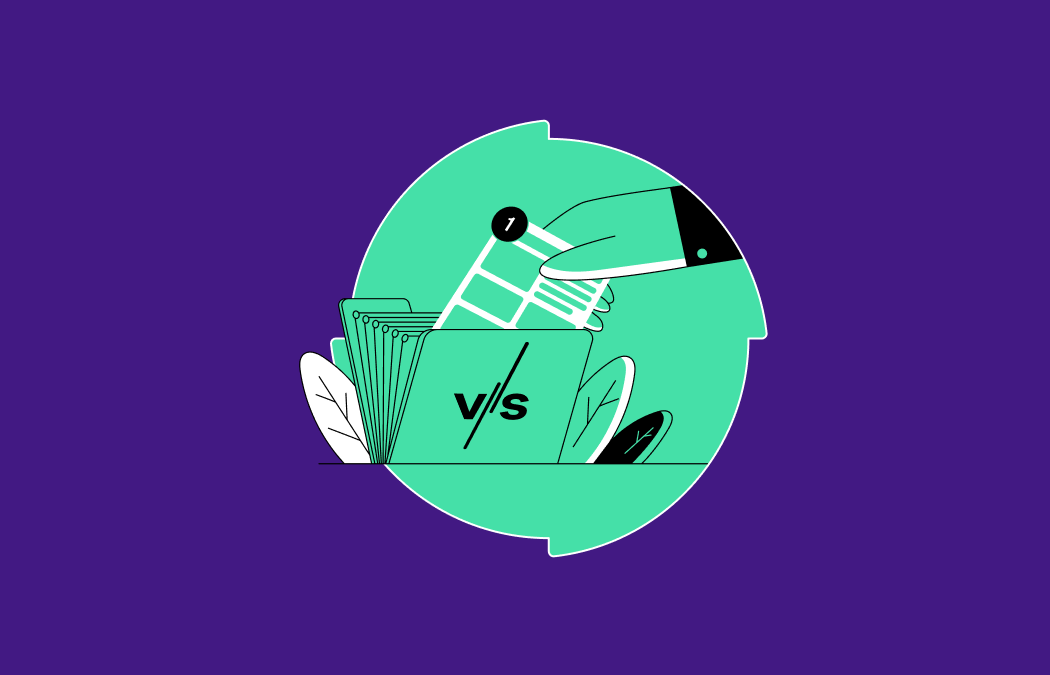
Hear that? That’s your competitor sneaking up on you, one campaign, messaging update, or channel adoption at a time.
You can stop looking over your shoulder though. Because, backed by competitive intelligence, you're about to go beyond intuition to uncover insights into competitor tactics, find what’s working for them, and then leverage that for yourself.
Whether you have a dedicated competitive intelligence team and you’d like to improve collaboration, or you’re looking to leverage some low hanging fruit and test the competitive intelligence waters on your own, there are a few simple competitive intelligence moves you can make to experience a world of difference in the effectiveness of your marketing and in your success in your market.
Knowing what your competitors are up to and what their customers say about them can help you to develop more informed and effective strategies. Our State of Competitive Sales study revealed that 57% of deals are competitive and participants cite “increased competition” as the number two reason for missing sales goals. And if you’re not hitting sales goals, are you really hitting marketing goals?
It’s easy to say we should “understand our competitors,” but what does that look like in reality? Let’s dig into a few practical ways to use competitive intelligence in marketing.
Choose just a few main competitors if you’re going to do this manually. Any more than five and you’ll struggle to keep up. If you’re using automation or have a competitive intelligence team, expand your tracking to include all direct AND indirect competitors.
Want more engagement and traffic for your content? Discover the most effective topics and channels for your audience before writing & distributing content by looking at what ‘s working for your competition. Using clickstream data, Semrush Traffic Analytics can show you top pages for your competitors’ websites, new pages, and pages with declining views.
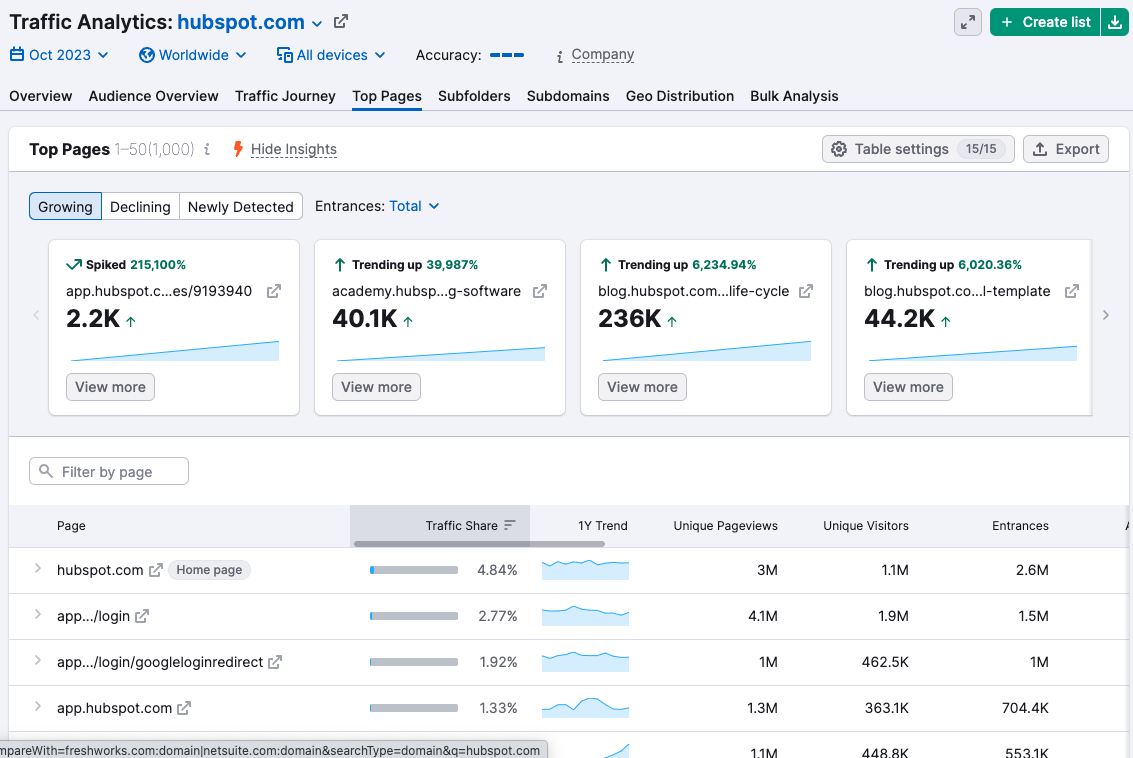
Watch your competitor’s traffic channels over time. Where are they focusing more today compared with six months ago? Is this a channel you might want to spend more time on?
When you're in Traffic Analytics, limit your view to one company on the "Overview" tab and you'll see a detailed breakdown of the channels sending traffic to that site.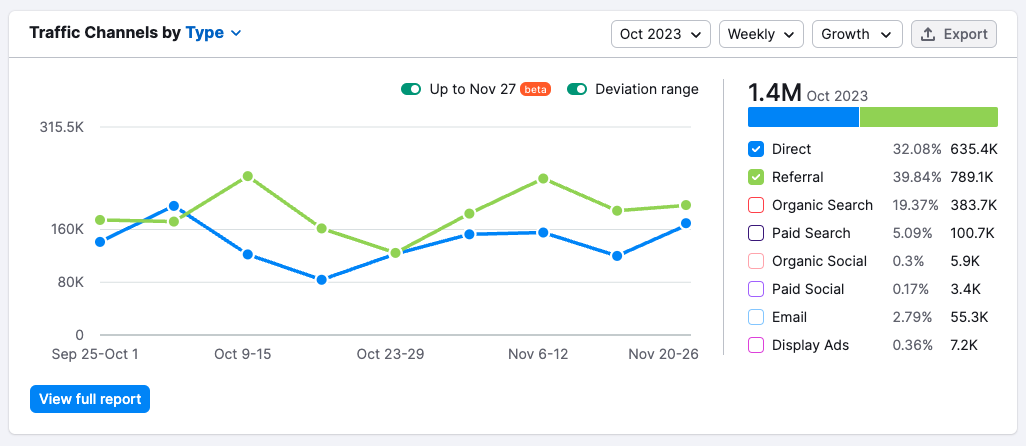
Identify opportunities to outperform the competition. Scan your competitors’ key pages (home, product, pricing) on a regular basis, looking for signs that indicate a change in direction and messaging. You could keep a folder with screenshots of these pages taken week by week and compare visually.
Or you could let Kompyte spot website changes and new promotions in real time for you.
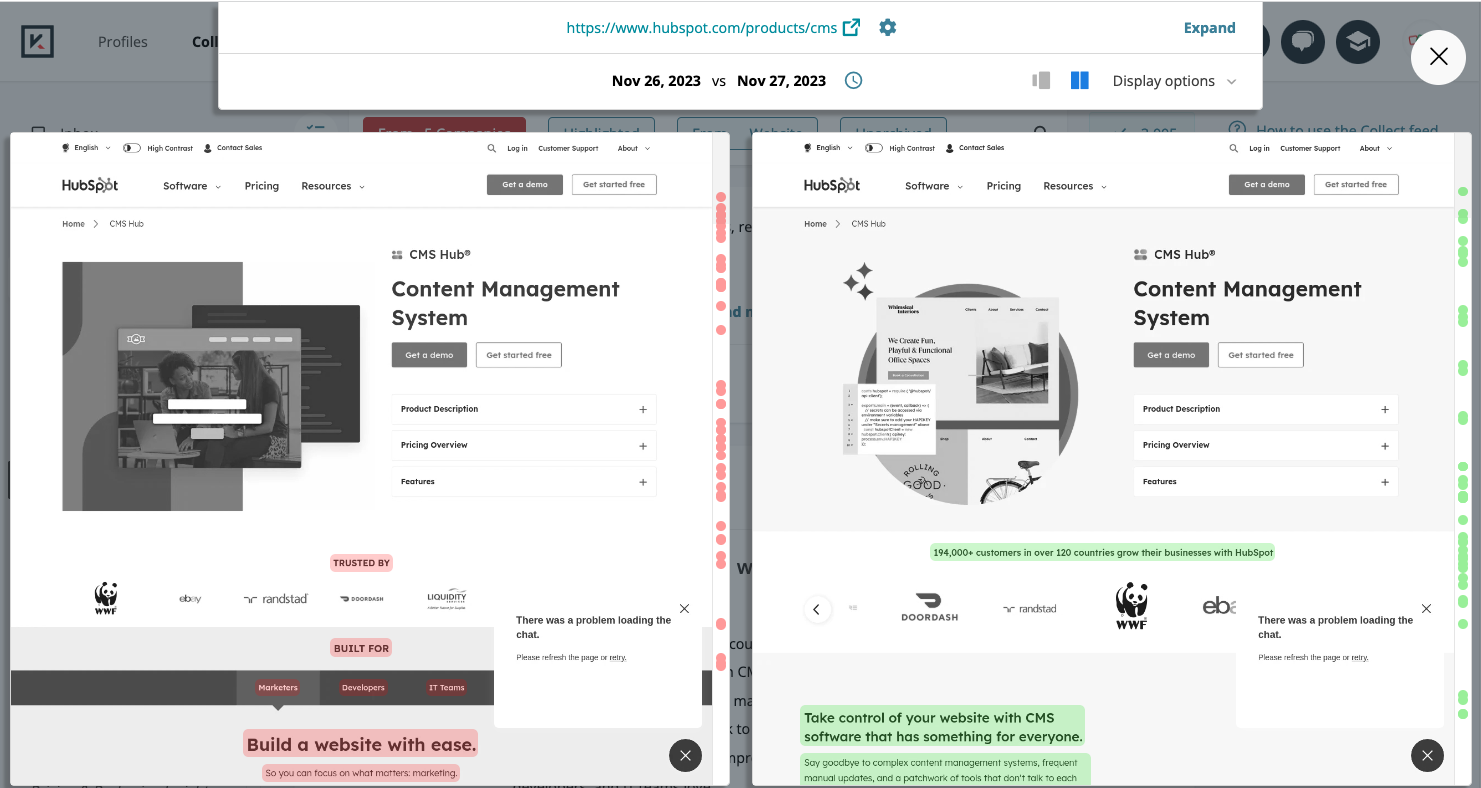
Find out where your competitors rank and you don’t in the Semrush Keyword Gap tool. You can also do this manually in an incognito browser window search by entering terms related to those you rank for, but the terms that pop up here are the ones you haven’t thought of, so that will be tricky.
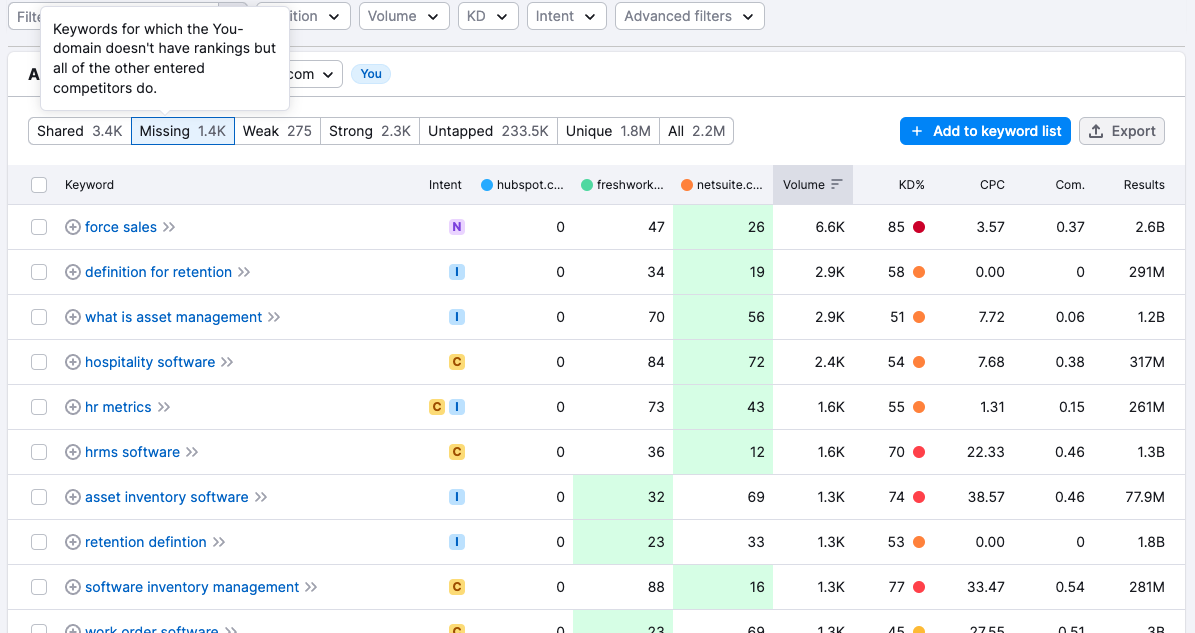
Optimize your website & landing pages based on what your competitors do. You can manually check your competitor’s Facebook pages to see which ads they’re running (go to About > Page transparency > Go to Ad Library).
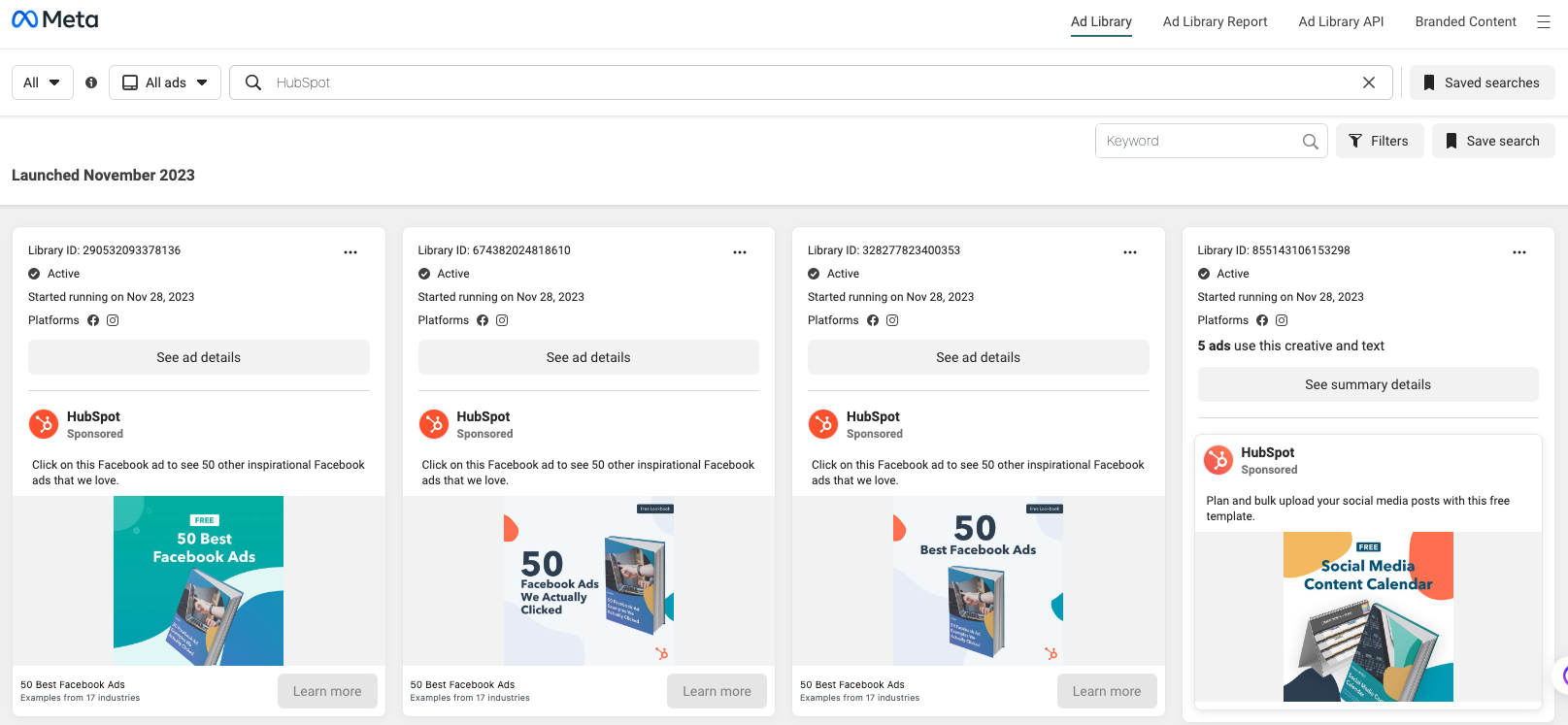
If you want to see search ads and learn how well those are performing, you’ll find some of them if you search for keywords you monitor. Or, check out the Kompyte Ad Timeline, where you can filter to see only ads for specific keywords if you’d like. See which ads are performing well (indicated by the green squares), then click through to get landing page inspiration.
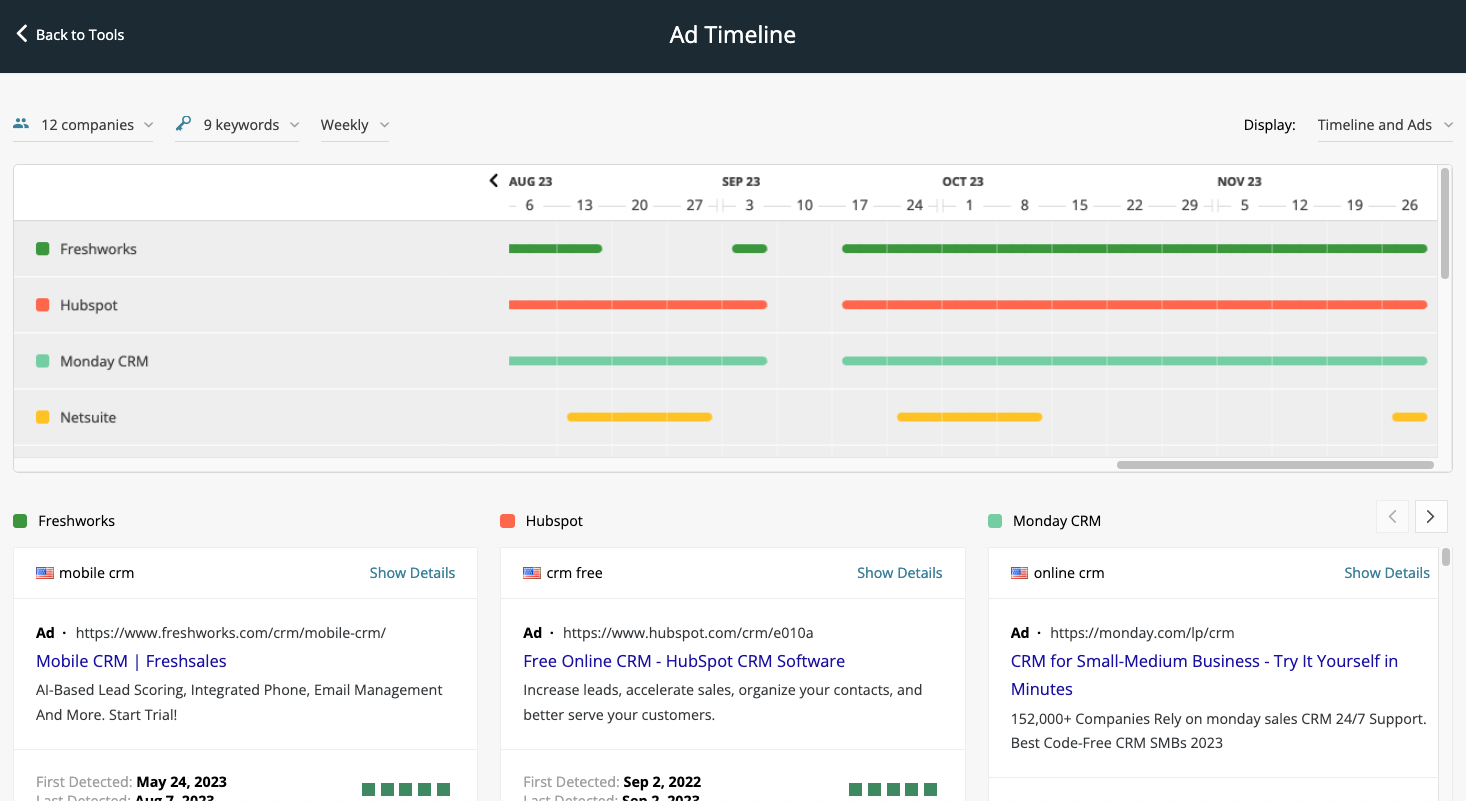
Kompyte will also alert you to new ad campaigns in real time if you’d like.
Benchmark your marketing efforts against your competitors to provide context for your performance and track your progress against them over time.
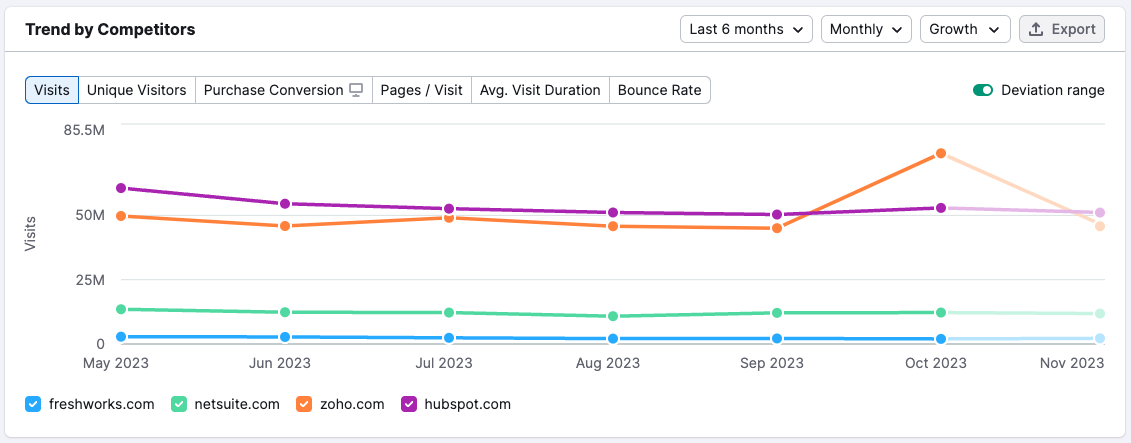
It’s nice to know if a drop in traffic is due to your marketing or due to market and seasonal forces across your industry. But also, what did Zoho do in October to cause that spike?! You can dig in to see traffic by channel and where the change happened.
In this case (because I know you’re wondering!), everything went way up (direct, display ads, referral, organic) except for email and social ads, so it’s a little hard to pinpoint the exact cause. BUT! I can also go back to Traffic analytics and find the pages that spiked this month and for each of those, I can see the referring channel. Like this:
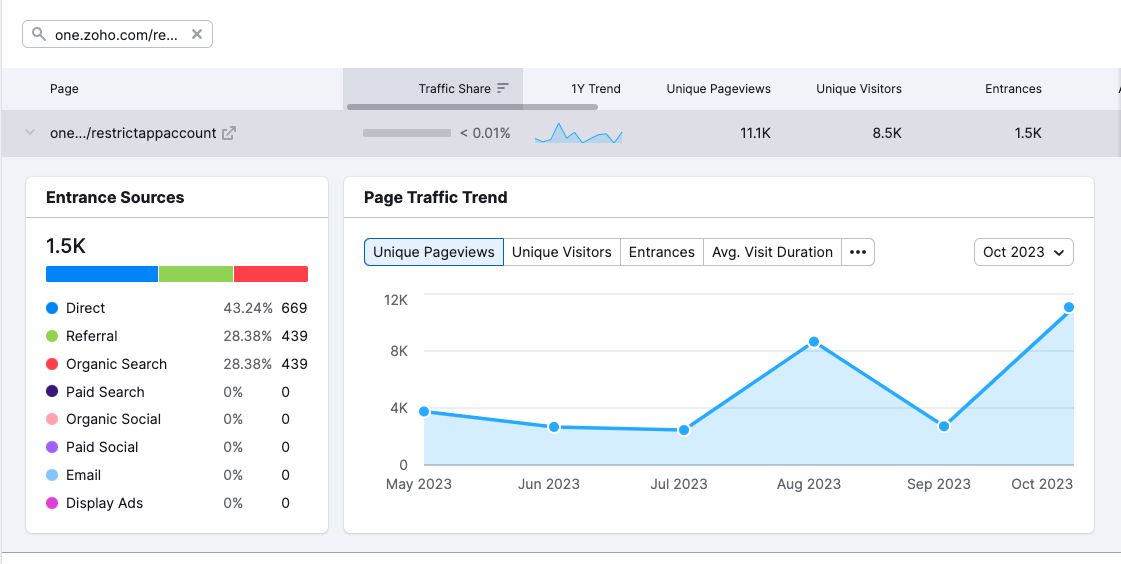
Oh, the rabbit holes you’ll find!
Learn how to make your product stand out from the competition by watching their content, social media, and ads.
If they cover a product integration addition with a “how to use X with Y,” and you have the same integration, you might decide to write something more broadly appealing, like how to use that integration to solve a problem or fill a need, mentioning your product as the hero. If their post featuring a cute dog did well … nevermind, of course it did…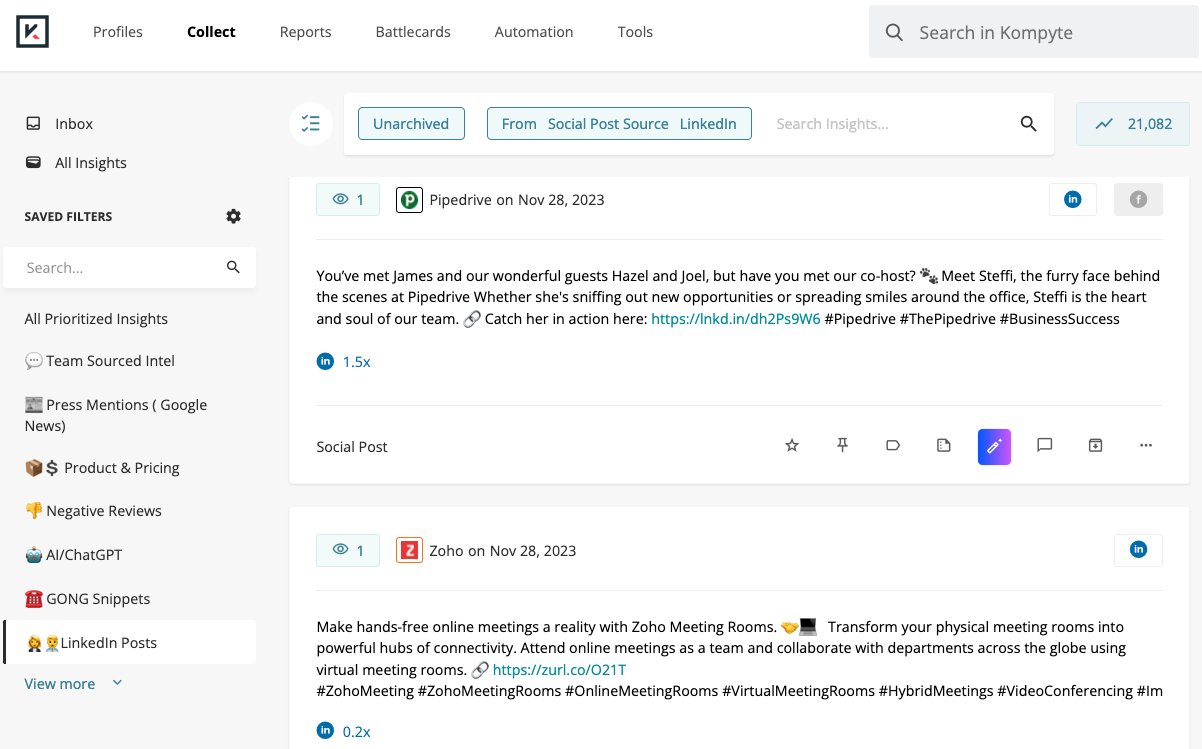
When you use Kompyte to track competitor updates, you can easily filter to see only what you want. In this case, we are looking at LinkedIn. See the little “in 1.5x” on the top update? That shows us that this update got 1.5x their usual engagement rate. Whereas the second update in the shot received only .2x the usual engagement rate. Try more dogs. ;)
You can also do this manually by reviewing individual social posts and looking for standout topics and styles of update.
Watch competitor reviews and get win/loss feedback to differentiate your offering and play to your strengths in your marketing messages.
Eg., if your competitors’ users consistently report difficulty in getting customer success, you should lean in to what your customers say about your amazing support team. Or, if you notice a trend of reviews mentioning dissatisfaction with a competitors’ email offering, and your customers LOVE yours, you should talk about that. :)
You can check review sites on a regular basis and most will allow you to filter by rating or keyword, but Kompyte makes it very easy to review the reviews!
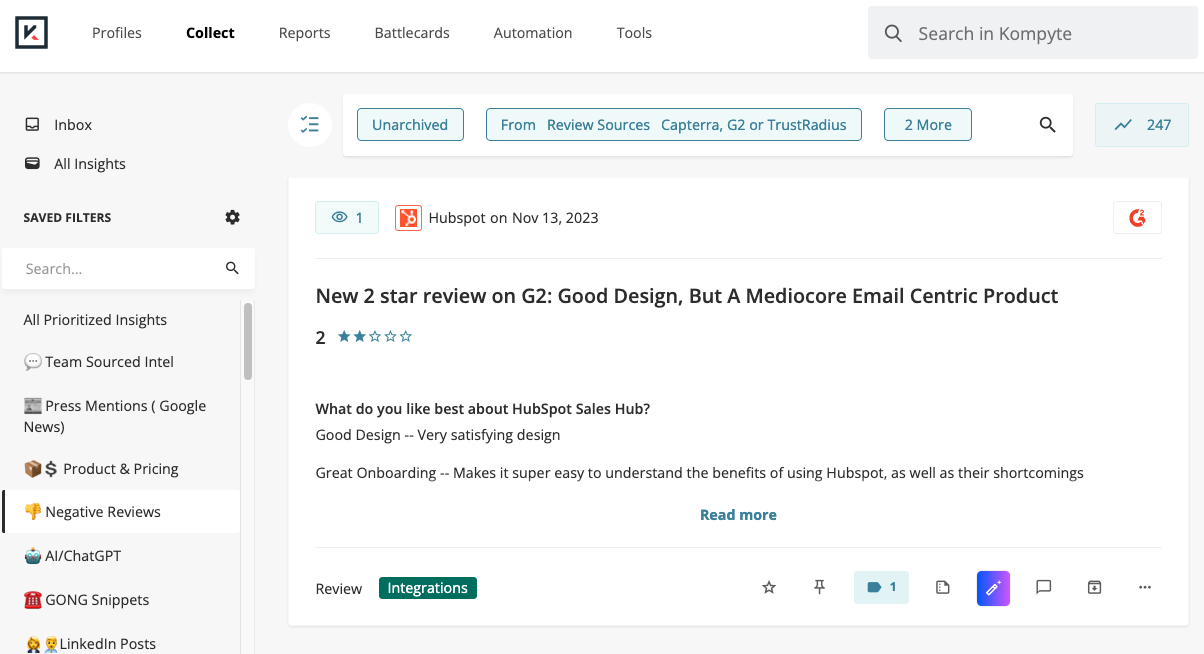
Win/loss interview data (here fictionalized), is full of insights into why you win or lose against competitors. You can keep yours in an Airtable or other location, or you can integrate them with Kompyte so all your competitive intelligence is in one spot.
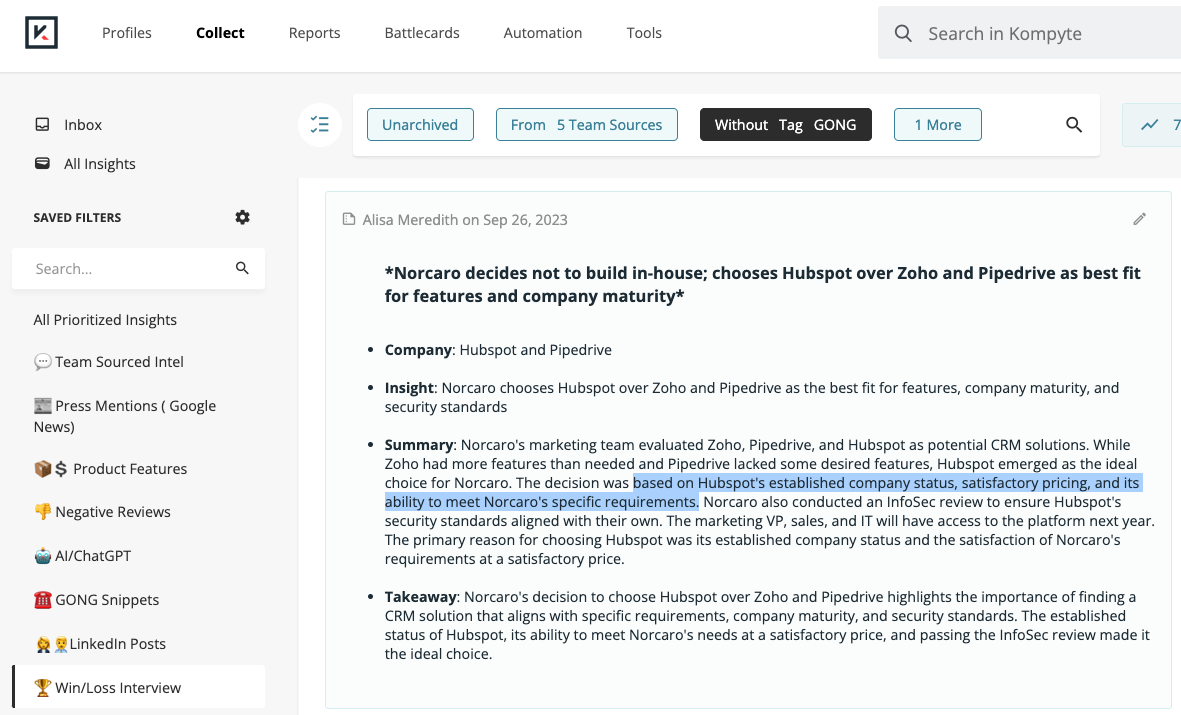
It’s not “spying” or corporate espionage. And it’s not shamelessly stealing ideas. Rather, for marketing, you’ll use what you learn to tailor what is working for your competitors, and what their users say about them, to your own business and your own audience. Think of it as inspiration gathering and as a way to let them test out new things so you don’t have to!
For example, if you notice a competitor’s homepage suddenly features all-new messaging, but it’s removed again in a week, you might conclude that that didn’t resonate with their visitors, so can cross that off your list. Or, if an ad is performing particularly well, you might consider running something similar, adding your own twist.
How, you ask, are you going to find all of this and organize it well enough so you can act on it? The first step is automation.
You can set aside time each week to review your competitors’ websites, social media accounts, keyword ranking, customer reviews, and more. But, best intentions aside, you probably won’t unless you automate as much as possible. It’s just too time consuming.
Competitive intelligence automation can track your competitor updates, then filter everything because you don’t have to know EVERYTHING that’s happening with your competitors, just the important things.
Depending on your industry, you may also need to be updated in real time when important updates occur, something that’s practical only with automation.
It’s one thing to capture important competitor updates, but if no one ever sees them, or can find them again, well, you may as well not bother.
Key is getting the information to the right people at the right time. If you have someone in charge of competitive intelligence, make sure you meet with them to let them know what you want to see, when, and where.
For example, let’s say you always want to know when your competitor launches new ad campaigns. But you only want to get updates on Monday mornings. Or, you want to know about new webinars or podcast episodes immediately. All possible.
Maybe you want to see product page updates right away and in Slack. Or, you prefer a weekly roundup of all blog posts in an email message on Thursdays.
Whatever works for your workflow, you can do that with competitive intelligence automation with Kompyte.
If you have your own project management system, like Trello or Monday, you can add individual insights to remind yourself to follow up on what you’ve learned.
Or, you can create your own Reports in your competitive intelligence tool. You might have sections for “website changes,” “customer reviews” (or even “negative competitor reviews”), “blog posts,” “webinars,” whatever brings you the most insight. You can add them manually, or, when you’re reviewing your insights, tag them to make sure they appear in the report where you want them.
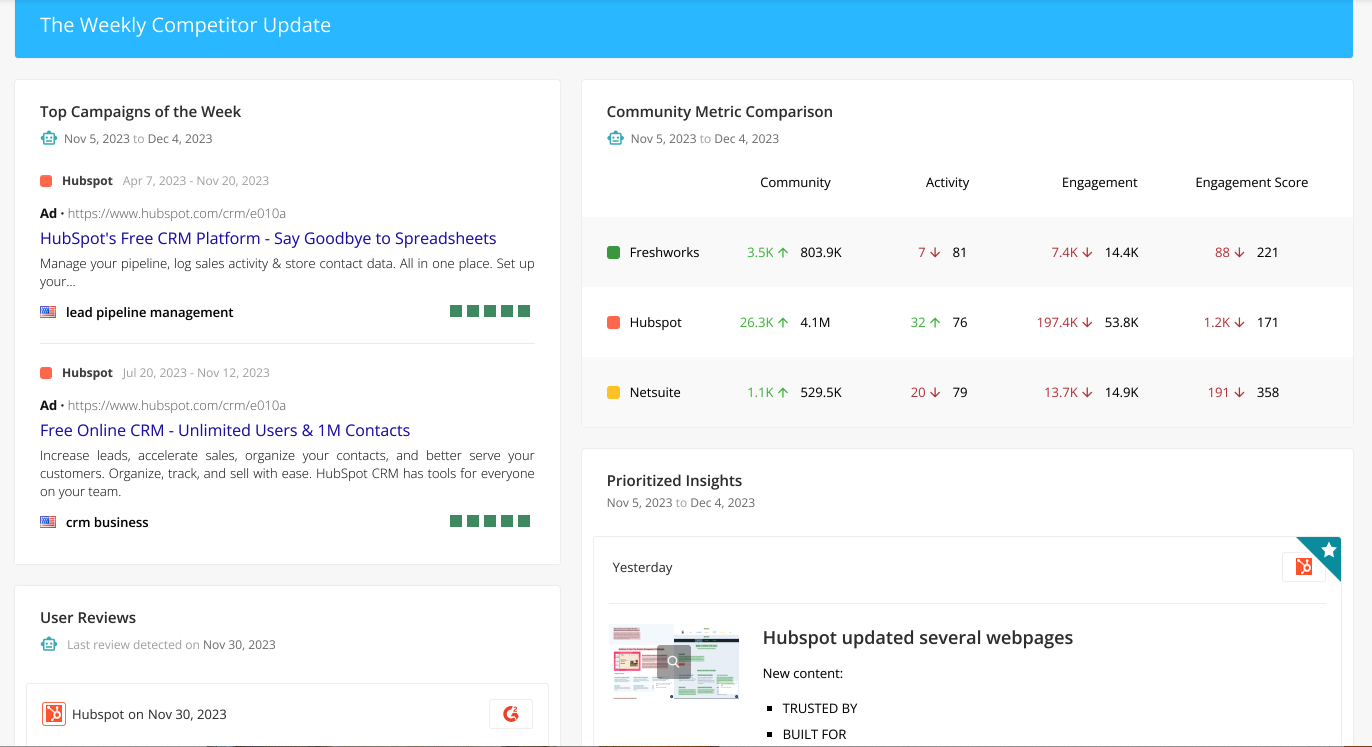
As you're collecting insights, unless you need to respond immediately, set a specific time to review your findings, and assign items to yourself or your team in your project management tool. Eg., if you spot that a competitor is starting to blog more often and is starting to overtake you in search engine rankings, you or your content department need to take a look at that, but you probably don't need to drop everything and address it now.
Any adjustments to strategy and tactics that come from your competitive intelligence efforts should be noted for follow up later. After all, if you don't see improvements from using competitive intelligence in your marketing, you don’t want to continue. On the other hand, if you DO (and you WILL), take note of which kinds of intelligence are most helpful. Do more of that and less of the rest to keep improving your results.
It’s not always easy to be consistent, especially if you’re trying to gather, curate, and share intel manually. Not to mention the fact that marketing budgets are slim, hiring is at a standstill, and the appetite for doing anything new and unproven is practically non-existent.
However, you’re not one to let things like that stop you. Take it on a little at a time if you need to and keep it organized. Show your small wins, and get buy-in for more investment in time and automation. “Piloted a competitive intelligence program to increase paid ad performance by 25% YOY,” would be a nice feather in your cap (and in your LinkedIn profile!).
Whether you're looking to increase your website traffic and share of search, improve engagement on social media, or get messaging and promotion ideas from your best competitors, competitive intelligence can provide just the glow up your marketing deserves.
Depending on available time and budget, start small or dive in head first. Choose what you'll monitor, how, and how you'll organize and act on what you find. That's it!
You've got this.
3 Underused, Highly Effective, Ways to Use Competitive Intelligence. See how you can learn from your competitor's mistakes, use real-time data to...
When most people think of competitive enablement, they automatically think of sales. But, they're not the only ones that can benefit from CI. Teams...
Competitor Analysis Report (Part V): Recognize your competition’s strengths and weaknesses and use the data to develop winning Sales Battle Cards.
Be the first to know about new B2B SaaS Marketing insights to build or refine your marketing function with the tools and knowledge of today’s industry.